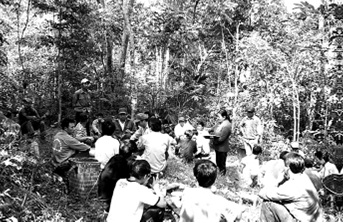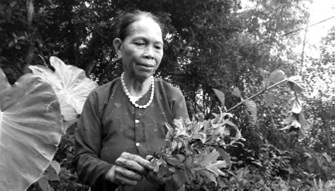

11/09/2017
There are seven ethnic communities living in Lạng Sơn province of which Tày people makes up 35.92%, and Nùng, Kinh, Dao, Hoa, Sán Chay and H’Mông. Making use of valley landscapes, Tày people have exploited the land area for paddy rice cultivation for many generations. However, to ensure food supply for the family, Tày people have changed the rice variety and improved the water irrigation system to increase crop intensification and expand the field. Particularly, Tày people also make use of water resources "bring water to the field" through the channel system. Therefore, Tày people have formed diverse traditional knowledge, particularly knowledge in land protection and water retention for agricultural production.

Meeting to select the group leader for protecting forests according to the village convention at Le village, Xuân Lễ commune (Lạng Sơn province)
Traditional knowledge of Tày people in protection of land and water resources
Land resource protection: Through many generations, Tày people have accumulated countless experience in protecting soil fertility for rice cultivation. For low lying fields, Tày people usually increase the humus for the field soil by ploughing before rice planting, then spreading manure in the field and evenly being harrowed by buffalos. Manure is made by bead tree leaves (xoan) and wild trees. In deep field foot, acid soil, Tày people implement top dressing by lime to reduce acidity. For terrace rice field, Tày people make the field bank of around 30 - 40 cm, covered by grass. The grass bank aims to protect the soil from landslides in heavy rain. For narrow fields, Tày people plant draught tolerant trees which also maintain the moisture of the soils such as cassava, maize and soy bean. For gardens, Tày people implements models that combine fruit trees, timber trees and industrial trees that bring high economic values.
In addition, Tày people apply slash and burn practice to convert forest land into fields, by burning bushes and dry leaves into ashes which provide nutrients for the soil. For slash and burn without causing forest fires, Tày people create a border line with the width of 2 - 3 m to prevent fires to get into the forest. For disease prevention, Tày people mix sliced bead tree leaves with ashes to spread in the fields, or spray the liquid of sour bamboo shoots mixed with betel on paddy rice when rice is affected with disease, without using chemical pesticides.
Water resource protection: According to Tày people’s opinion, clean water source is very important; therefore, they use bamboo pipes to transmit water and to avoid pollution of the water source. For water used for daily domestic activities, which relates directly to human health, Tày people select substantial water flows from original sources, from the upstream, and to transmit to households.
For water use in agriculture production, Tày people make embankment, implement water retention to create water flows, and then dredge small channels along hill sides to transmit water into the field. In addition, water is transmitted to high fields through water wheels and the flows of springs are controlled to make the flows stronger.
Protection of environment and forest resources through village conventions: Through long connection with forest and mountains, Tày people have accumulated knowledge and experience in protection of forest resources and environment which are illustrated in village conventions. The village convention consists of two parts including responsibility of local people on environmental protection; penalty mechanism for non-compliance with environmental protection regulations.
Accordingly, the village convention clearly identifies the responsibility of local people in forest protection and exploitation such as: no cattle in the forest; no animal hunting, trapping, catching... in the forest; in dry season, individuals and households prepare the forest prevention line in hotspots which forest fires are prone to occur in natural forests and plantations; field cultivation in the forest and near the forest must follow the guidance, supervision, and monitoring of the village head, forest staff and forest rangers in the area; when the forest owner want to use the forest at its exploitation age, the forest owner must apply for exploitation permission and count the number of trees, area, and volumes of trees to be cut and submit to the authorized agency for permission. In terms of environmental protection, households participating in manufacturing, commercial and domestic activities do not dispose waste, refuses, and wastewater which cause environmental pollution, without prior treatment to public areas. Households in the village must have sanitary, clean, and close toilets. Wells, water tanks, bathrooms… are sanitary. Animal corpses must be landfilled and must not be thrown into water sources that cause environmental pollution.
Regarding the penalty mechanism, the village convention regulates compulsory penalties for violation behaviors "if individuals, households, and organizations violate forest protection and environmental protection regulations, they are subject to warnings and condemnation in community meetings and the violation is recorded to submit to the authorized agency for appropriate penalties. The first and slight negative impact violation will be subject to warning and condemnation in village meetings; second and subsequent violations, based on community consensus, will be subject to criticism in community meetings; and the title of "cultural family" (for households) will not be considered, a maximum of 40,000 VND must be contributed to the community fund or work days for village activities such as clearing village roads, cleaning village cultural house… must be contributed". In other words, the village convention regulates two penalties: Village regulations and legal documents.
Proposals of some solutions
Traditional knowledge in natural resources management of Tày people has brought high efficiency in environmental protection. Nowadays, despite technical scientific development, concretization of channels to each village, the value of traditional knowledge of Tày people in land and water resources use and management still remains. This not only contributes significantly to daily activities of local people but also contribute remarkably to the legal enforcement in natural resources protection in mountainous provinces.

Mrs. Hà Thị Lỵ (Bắc Lạng commune, Đình Lập district, Lạng Sơn province) owns many precious medicine recipes from local herbs
For farmers to improve their livelihoods and to participate in forest protection and environmental protection based on traditional knowledge, it is necessary to have solutions to support the development of local people, specifically: It is necessary to study and document knowledge on forest resources use and management in order to integrate adequate traditional knowledge in activities to achieve sustainable conservation targets; encourage and promote existing village management mechanism, develop village conventions and documentation; develop agro forestry models, protect and sustainably use non-timber forest products based on the application of traditional knowledge in combination with advanced and modern scientific knowledge; combine communication, education, and awareness raising for Tày people with wise use and exploitation and sustainable management of forest resources; restore and develop the traditional craft to create more incomes for local people from cultural traditional products…
Nguyễn Thanh Thủy, Cao Thị Thanh Nga
Vietnam Academy of Social Sciences